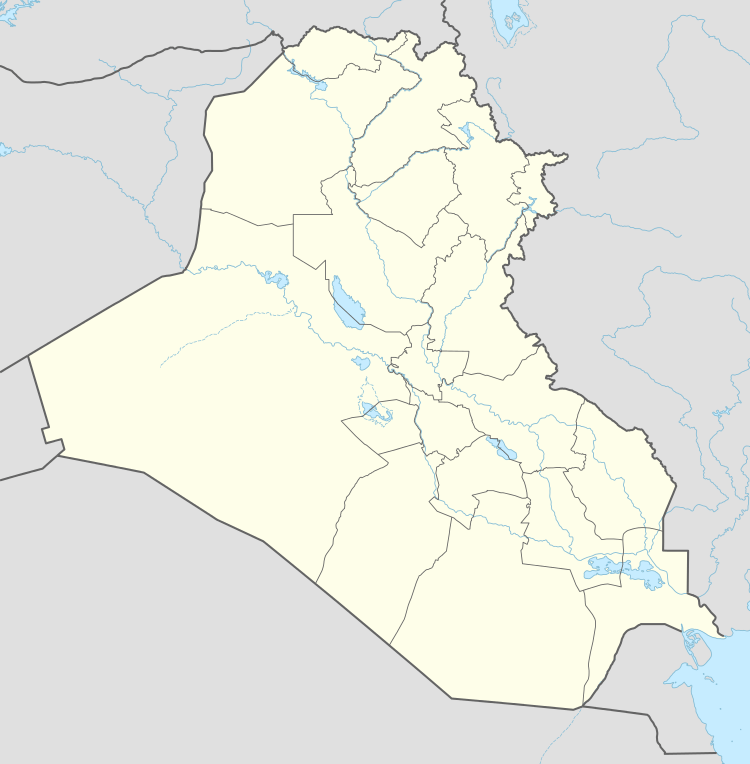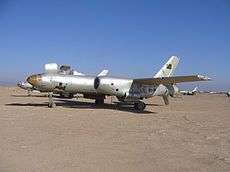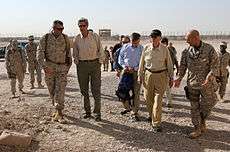Al-Taqaddum Air Base
Al Taqaddum Airbase (Arabic: قاعدة التقدم الجوية), or Al Taqaddum AB (IATA: TQD, ICAO: ORAT), (Called TQ in military shorthand slang), is an airbase that is located in central Iraq, approximately 74 kilometers west of Baghdad, at Habbaniyah. The airfield is served by two runways 13,000 and 12,000 feet (3,700 m) long. Since 2004, it has been known as Camp Taqaddum. ("Taqaddum" is an Arabic word which means "progress".)
Al Taqaddum Air Base Habbaniyah Plateau | |||||||||||||||
|---|---|---|---|---|---|---|---|---|---|---|---|---|---|---|---|
| Summary | |||||||||||||||
| Airport type | Military: Airbase | ||||||||||||||
| Operator | Iraqi Armed Forces | ||||||||||||||
| Serves | Al Fallujah, Iraq | ||||||||||||||
| Location | Habbaniyah | ||||||||||||||
| Elevation AMSL | 275 ft / 84 m | ||||||||||||||
| Coordinates | 33°20′22″N 043°35′24″E | ||||||||||||||
| Map | |||||||||||||||
 Al Taqaddum Air Base | |||||||||||||||
| Runways | |||||||||||||||
| |||||||||||||||
No ILS | |||||||||||||||


The airbase was originally built by the Royal Air Force (RAF) in 1952 as the subsidiary PLATEAU AIRFIELD of nearby RAF Habbaniya, whose runway was inadequate for the larger long range and jet aircraft being introduced. The original RAF runway was subsequently extended by the Iraqis and a parallel runway added. Some of the RAF buildings (Nissen huts) were still standing in 2003.
History
Iraqi Air Force use
Al Taqaddum Airbase was known as "Tammuz Airbase" (Tammuz being the Babylonian month the Baath Party came to power in Iraq), and various Iraqi Air Force units and squadrons used it.
The airbase was bombed in Operation Kaman 99, the day after the beginning of the Iran–Iraq War.
Units and squadrons present before 2003:
- 14th Squadron Mikoyan-Gurevich MiG-21
- 73rd Squadron Mikoyan-Gurevich MiG-23
- 6th Squadron Mikoyan-Gurevich MiG-29
- 5th Squadron Sukhoi Su-22
- 105th Squadron Sukhoi Su-25s
- 109th Squadron Sukhoi Su-25s
Fifty-one different Iraqi Air Force aircraft were found hidden under camouflage nets near al-Taqaddum by the Australian Special Air Service. Although still only scant details are known about these aircraft, US and British military sources reported that these 51 aircraft included three MiG-25s (including a single MiG-25PU two-seater), a Su-25K and a Su-7U, a MiG-29, several F-7Bs and Su-22UM-3Ks, as well as one Ilushin Il-76 transport.
U.S. forces also found the hulks of five remaining Iraqi Tupolev Tu-22B "Blinder" supersonic bombers. All were still sitting in the revetments where they had been hit and destroyed by Coalition air attacks in 1991. Near them the wreckage of the Adnan-1 AEW aircraft, a third example was found, also destroyed by air attacks in 1991, as well as the wreck of the last Iraqi Tu-16 or H-6D bomber, which survived 1991, and was made operational in 2000 again: this old bomber was observed in flight – together with the sole surviving Iraqi Su-24MK – as late as February 2003, but was then obviously hit by US air strikes.
The last Iraqi Su-24MK was apparently captured intact, and there are rumours that it was meanwhile flown to the USA as well. Another rarity reported to have survived the war at al-Taqaddum were several Ilyushin Il-28 "Beagle" bombers, including one Il-28U training aircraft. Supplied to the IrAF in 1960, this aircraft must have certainly seen quite some service history: they were used during the extensive campaigns against Kurdish rebels, in the 1960s, mid-1970s, and mid-1980s during the war against Iran.[1]
Iraq War from 2003
The Iraqi airbase was long-abandoned when U.S. forces occupied it in March 2003. The U.S. Army started to refer to the base as Forward Operating Base (FOB) Ridgway. The first U.S. Battalion to occupy the base was the 142nd Corps Support Battalion. The primary mission of the 142nd was to provide logistical support to nearby non-divisional Army units. However, a consequential mission of the 800 soldier battalion was to guard the local Iraqi ammunition storage area that at one time supplied the ammunition requirements of the defunct Iraqi airbase. Aviation elements of the 3rd ACR occupied the airfield from April 2003 until replaced by 82nd Airborne Division in July 2003.
In 2004, the base name was changed to Camp Taqaddum to keep a more Iraqi face on the local military mission. "TQ" served as a major hub of men and materiel moving into Anbar province by coalition forces in Operation Iraqi Freedom.
According to the Gulf War Air Power Survey, there were 24 Hardened Aircraft Shelters at Al Taqaddum. At each end of the main runway are hardened aircraft shelters knowns as a HAS (pronounced Haas), "trapezoids" or "Yugos" which were built by Yugoslavian contractors some time prior to 1985. Various units of the U.S. Army found numerous MIG-21, MiG 25 and Su 25 Iraqi Air Force fighter jets partially buried in the area, presumably from the time of the Gulf War. By January 2004, almost all of the dozens of aircraft had been removed by the local citizens and burned, evidently, for scrap metal.
There are three "sides" to Al Taqaddum, "Lake Side", "Main Side", and "Spring Lake". These sides denote particular areas. Each area has its own chow hall and phone center. The PX and main military support services are located on "Main Side". "Lake Side" hosts the air terminal and the primary supply depot. "Spring Lake" hosts other logistics units.
TQ is adjacent to Lake Habbaniyah. This lake varies in colors, blue some days, to a greenish tint on others. The base is built on a desolate plateau overlooking the Euphrates River to the north and Lake Habbaniyah to the south. A drainage canal from Lake Habbaniyah flows between it and the base at Habbaniyah.
In late 2009 Al Taqaddum was turned back over to the Iraqi Military.
Greene Field
On August 22, 2004, a group of Marines dedicated the airfield at Al Taqaddum to Lt. Col. David S. Greene, a reserve Marine AH-1W Super Cobra pilot with Marine Light Attack Helicopter Squadron 775, Marine Aircraft Group 16, 3rd Marine Aircraft Wing, who was killed in action July 28, 2004. Greene was flying a mission in support of I Marine Expeditionary Force when he was killed by small arms fire.[2]
List of Marine Corps units since 2004
- Marine Corps Systems Command (MCSC) Special Unit - (To install Armor on all HMMWV (Humvee))[3]
2004-2006 2nd TSB transportation support battalion (known now as 2nd MSG Marine logistics Group)
- 8th Engineer Support Battalion between 2005 and 2006 (USMC - Camp Lejeune)[4]
- Marine Medium Helicopter Squadron (HMM-263) July 2004 - Feb 2005
- Marine Medium Helicopter Squadron (HMM-364) Feb 2005 - Sept 2005
- HMM-268 during 2006.[5]
- HMM-161 from February to September 2007.[6]
- HMM-161 from September 2008 to April 2009.[6]
- Marine Light Attack Helicopter Squadron 775 (HMLA-775) during 2004[2]
- Unknown squadrons between 2004 and 2005.
- HMLA-369 from 2005 until April 2006.
- HMLA-169 until October 2006.[7]
- HMLA-367 from October 2006 to May 2007[7]
- HMLA-369 from April 2007 to November 2007[8]
- Unknown squadron between November 2007 and October 2008.
- HMLA-369 from October 2008 to May 2009[8]
- Marine Unmanned Aerial Vehicle Squadron 2 (VMU-2) during 2007.[9]
- Marine Wing Support Squadron 373 (MWSS 373) August 2004, September 2006 to March 2007 and September 2008 to April 2009.[10]
- MWSS 374 2004, March 2006[11] and 2008.
- MWSS 371 between February 2005 and September 2005.[12]
- MWSS-274 between 2007 and 2008.
- MWSS-272 between 2007 and 2008.
- VMU-1 between 2005 and 2009.
- Marine Aviation Logistics Squadron 16 (MALS-16), Detachment A from March 2006.[5]
- MALS-29, Detachment A during 2007.[13]
- Marine Air Control Squadron 2 (MACS-2), Detachment A from July 2006 until August 2007.[14]
Current use
The base is home to the 10th Iraqi Army Division and the Anbar Operations Command Center. Since 2016 part of the base was called Camp Manion which is home to Task Force Spartan which consists of I Marine Expeditionary Force and augments from Special Purpose Marine Air-Ground Task Force – Crisis Response – Central Command, as well as U.S. Soldiers with 1st Infantry Division, Airmen with United States Air Forces Central Command, and components of the Australian and Italian armed forces, with medical support from 772nd Forward Surgical Team, the 115th Combat Support Hospital and U.S. Navy Corpsmen with II MEF and SPMAGTF-CR-CC.[15]
On April 5, 2020, the US-led CJTF–OIR handed over the base to Iraqi security forces by the last Commander of Task Force Spartan, Col Scott Mayfield.[16][17]
See also
| Wikimedia Commons has media related to Al Taqaddum Airbase. |
References
- Second Death of IrAF
- "Marines dedicate Al Taqaddum airfield to fallen aviator". USMC. March 3, 2019.
- "Archived copy". Archived from the original on 2012-06-22. Retrieved 2012-06-17.CS1 maint: archived copy as title (link)
- "'SeaBees' repair runway at logistics 'hub'". USMC. March 3, 2019.
- "Det-A Marines bring aviation logistics support to Al Taqaddum". USMC. March 3, 2019.
- "Marine Medium Tiltrotor Squadron 161". USMC. March 3, 2019.
- "HMLA-367 returns to Al Taqaddum mission ready". USMC. March 3, 2019.
- "Commanding Officer". USMC. March 3, 2019.
- "VMU-2 mechs maintain unmanned aircraft". USMC. March 3, 2019.
- "Marine Wing Support Squadron 373". USMC. March 3, 2019.
- "MWSS-374 Marines awarded Purple Heart in Iraq". USMC. March 3, 2019.
- "Sand Shark mechanics keep Al Taqaddum's engines running". USMC. March 3, 2019.
- "MALS-29 Det A provides supply, support squadrons of Al Taqaddum". USMC. March 3, 2019.
- "MACS-2 Marines return from Iraq". USMC. March 3, 2019.
- "Task Force Al Taqaddum". USMC. March 3, 2019.
- "US hands over another air base to Iraqi forces". MilitaryTimes. April 5, 2020.
- "Marines, Coalition Forces Pull out of Iraq's Taqaddum Air Base | Military.com". Military.com. April 5, 2020.
External links
- Al Taqaddum Airbase from Globalsecurity.org
- Airport information for ORAT at World Aero Data. Data current as of October 2006.
- "Exhumating the Dead Iraqi Air Force" – article on uncovering 30 to 40 Iraqi Air Force aircraft buried at Al-Taqaddum Air Base.